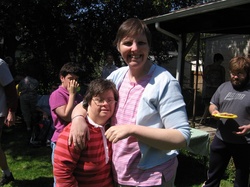Yesterday afternoon, Penny couldn’t have been more excited
when I said, “Pen, would you like to do a worksheet that your teacher sent home
for you?” “Homework? Yes!”
We sat at the kitchen table. She circled the “tall” person,
the person “in front,” the item “behind.” She named three things you can find
on a playground. She wrote “SLIDE” with my help. We had a great time, and I’m
ever thankful for her teachers who sent us home for the summer with a stack of
worksheets Penny will enjoy.
A week ago Sunday, the New York Times ran a cover story
about educating children with severe disabilities. The article describes
Donovan, a young man who suffered a serious brain injury as an infant. He is
blind. Most days, his hands are covered by large mitts to prevent him from
harming himself. He has difficulty expressing himself in a way that is clear
his aids or teachers. He receives his education through the public school
system, at triple the cost of educating a “typical” student. From the way the
article describes his situation, it is hard to conclude that Donovan is
learning. From what I can tell, Donovan’s physical needs must be addressed
before any educational goals can be achieved. For instance, one day a teacher
massaged his hands and arms, leaving them relaxed enough that he didn’t need to
wear his mitts for the rest of the day. Most days, for whatever reason, there
is no massage and the mitts are on.
But is it the school’s responsibility to address those
physical needs? And should taxpayers pay the high bill for his education,
especially when it isn’t clear what he’s learning? Should we as a society care
about Donovan? Should we care about Penny? Should we spend money to care for them?
To educate them? And if so, how?
In 1975, Congress passed a bill that mandated education for
children with disabilities. That education has taken many forms in the
intervening decades, and it still varies in quality from state to state and
school to school. For Penny, the emphasis upon learning in an integrated
setting and the assumption that she will have academic goals just like the
other kids, has been a great gift. She loves school. She loves her teachers and
friends. Special education seems to be “working” for Penny. It doesn’t seem to
be “working for Donovan.
And yet even as I write my “success” story, the questions
remain. A team of seven individuals attended to Penny’s needs this past school
year–the school psychologist, who administered her Individualized Education
Plan (IEP), her two classroom teachers and the classroom aide, her speech
therapist, physical therapist, and occupational therapist. The pre-school
program itself only exists because of kids like Penny. Because it is
educationally appropriate for her to learn alongside typical peers, eight
typically-developing kids in our district get a free spot in pre-school. So
educating Penny (at least from the perspective of the public schools) starts
earlier than it does for most kids. It involves more people. And it costs more.
Is it worth it?
It’s worth it for Penny. She’s thriving–physically, emotionally, socially, academically. I hope that it is worth it for everyone else. I hope it is worth it for the kids in her classroom who are growing up with the expectation that they can be friends with kids who are different from them.
It comes down to a question of value. But that value is not measurable with dollars and cents. It can never be plotted on a chart or a graph. One person, in commenting on the New York Times article, wrote about diverting funds from programs for academically gifted kids rather than changing the funding structure for kids with disabilities: “Folks, we are polishing stones and dulling diamonds. We are consigning our best and brightest to mediocrity. We are spending 5 to 10 times as much on students who will never be the backbone of society, never be able to consistently hold a job.”
If all that matters is whether we produce workers who will prosper economically, then he’s right. Donovan, and perhaps Penny, should be left behind. But if instead we recognize the inherent value of every human being, the question becomes much more complicated. Donovan and Penny–like you and I–have value because they are human beings, created in the image of God. That value has been bestowed upon them. They have gifts to offer their communities, if only the rest of us have the humility and wisdom to receive those gifts.
So where does it leave us? It still begs the question of how to best care for individuals with severe disabilities, how to ensure that their physical needs are met first so that they might flourish in other aspects of their being. But it also holds forth the hope that we are becoming a culture in which differences, even intellectual differences, are of value to all of us. Perhaps someday we’ll be able to see the worth of all these kids. Perhaps someday we’ll be able to see that they are all diamonds.


